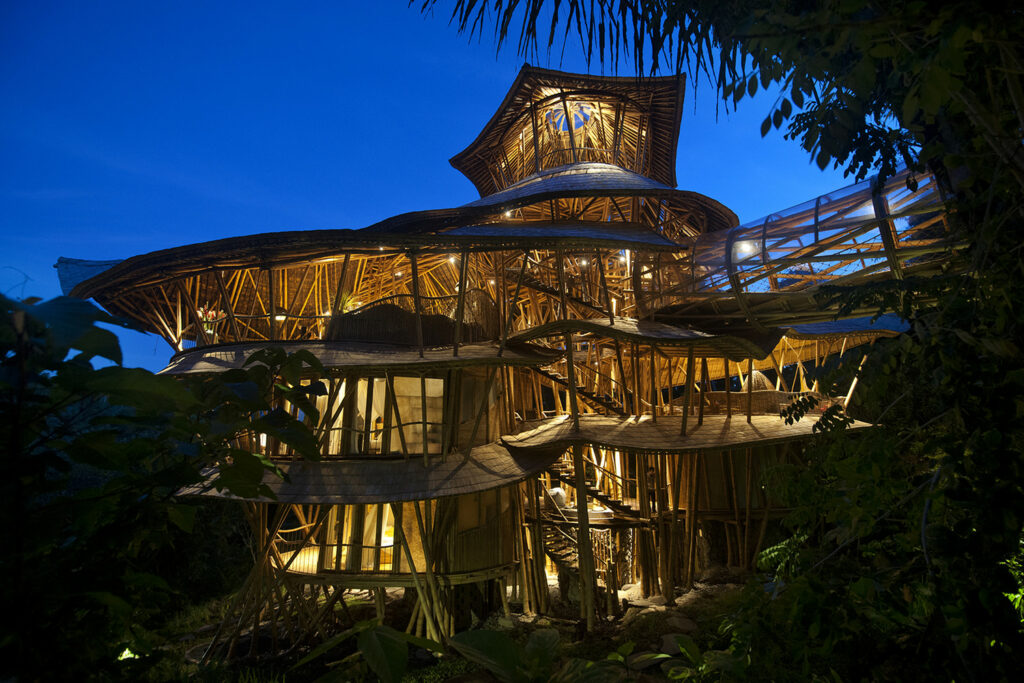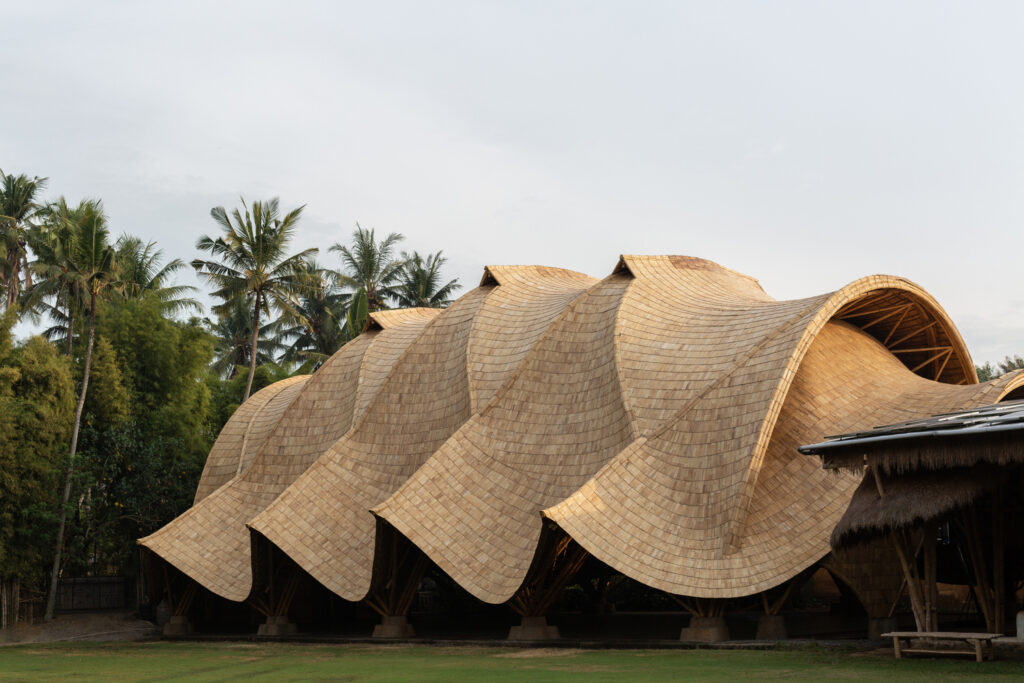Unlock Premium, Members-Only Content
Your source for the most relevant updates in sustainable construction
Bamboo: it’s not just for pandas. This fast-growing grass has muscled its way into the architectural spotlight, promising a greener footprint without skimping on style or substance. Let’s dive into the world of bamboo construction and uncover how it’s bending the rules of traditional building.
Introduction to Building with Bamboo
Bamboo isn’t just another building material; it’s a revolution in the making. With a growth cycle that puts traditional hardwoods to shame and a strength-to-weight ratio that rivals steel, bamboo is stepping up as the eco-warrior of modern construction materials.
Quick Facts:
- Growth Cycle: Can grow up to 35 inches in a single day.
- Strength: Comparable to steel in tensile strength.
- Sustainability: Highly renewable with a significant carbon sink capability.
Bamboo’s journey from ancient material to modern marvel is not just about its environmental benefits. It’s about reimagining what buildings look like and how they function in harmony with nature.
Historical Context of Bamboo in Architecture
Tracing back thousands of years, bamboo has been a cornerstone in Asian architecture, revered for its resilience and versatility. But its use isn’t just a tale of the past; it’s a living, evolving tradition that has seen a resurgence with a modern twist.
Timeline of Building with Bamboo:
- Ancient Asia: Used for everything from homes to bridges.
- 20th Century: Marginalized by industrial materials.
- 21st Century: Revived interest due to sustainability concerns.
Today, architects and designers around the globe are tapping into this ancient wisdom to craft structures that are not only sustainable but are also architectural masterpieces. The fusion of historical methods with cutting-edge technology is setting the stage for a bamboo renaissance.
Selecting the Right Bamboo Species
Not all bamboos are created equal. With over 1,600 species, picking the right type for construction is crucial. Here’s what you need to know to make an informed choice.
Bamboo Selection Guide:
| Criteria | Details |
|---|---|
| Species | Less than 50 are ideal for construction. |
| Size | Ideal height is over 12 meters. |
| Diameter | Suitable diameter for structural strength. |
| Age | Mature poles, typically 3-4 years old, are best. |
Selecting the right bamboo involves understanding its growth patterns, structural properties, and suitability for the climate you are building in. The perfect bamboo species for a tropical beach house may not be the best for a mountain retreat.
Innovative Building Techniques with Bamboo
The way we build with bamboo is changing, thanks to cutting-edge techniques that push the boundaries of architectural design. Here’s how innovation is reshaping bamboo construction, making it not only sustainable but also a frontrunner in architectural design trends.
3D-Printed Bamboo Connectors
One of the latest breakthroughs in bamboo construction involves the use of 3D-printed connectors. These connectors are designed to perfectly match the unique contours of bamboo poles, allowing for more complex structures and designs. This method enhances the structural integrity of bamboo buildings while maintaining their natural aesthetic.
Hyperbolic Paraboloids in Bamboo
Imagine a structure that looks like a Pringle chip but performs like a superhero in architectural design. Hyperbolic paraboloids, or “hypars,” are being used in bamboo construction to create roofs and shelters with a visually striking, curved appearance. These shapes are not only aesthetically pleasing but also structurally advantageous, distributing loads evenly and offering great resistance to external forces.
Architectural Wonders: Building with Bamboo Case Studies
Bamboo isn’t just for small, eco-friendly homes. It’s making a mark on the world stage with some jaw-dropping structures that demonstrate its versatility and strength. Here are a few standout projects that showcase bamboo’s potential in modern architecture.
Sharma Springs by IBUKU

Photo: Rio Helmi, Errol Vaes
Nestled in the Balinese jungle, Sharma Springs is a stunning six-story bamboo house designed by IBUKU. This architectural masterpiece features a remarkable open-air design, providing breathtaking views and showcasing the possibilities of bamboo in large-scale luxury construction.
Green School Bali

Photo: Tommaso Riva
Also designed by IBUKU, the Green School in Bali is an eco-campus built almost entirely from bamboo. It serves as a global model for sustainable education spaces, with classrooms, gyms, and bridges all made from this versatile material. The school’s design emphasizes natural ventilation and light, proving that bamboo can be both functional and beautiful in educational architecture.
Building with Bamboo: Practical Building Tips
When it comes to building with bamboo, the devil is in the details. Whether you’re an experienced builder or a curious newbie, these practical tips will help you get the most out of this flexible, robust material.
Site Preparation
Before laying the first bamboo pole, ensuring that the building site is properly prepared is crucial. This includes assessing soil stability, clearing vegetation, and ensuring easy access for transporting materials. Proper site preparation prevents future structural issues and enhances the longevity of the bamboo structure.
Bamboo Treatment
To ensure durability, bamboo must be treated against pests and environmental decay. Techniques such as soaking in borate solutions or using traditional methods like smoking over a fire can significantly extend the life of bamboo structures. Each method has its specifics and choosing the right one depends on local conditions and available resources.
Building with Bamboo: Quality Control
Consistency is key in bamboo construction. From selecting uniformly strong poles to ensuring that joints and connections are secure, rigorous quality control must be maintained throughout the building process. This ensures not only the structure’s aesthetic appeal but also its safety and durability.
Bamboo for Different Building Components
Bamboo is not just versatile; it’s a master of adaptation, fitting into various aspects of a building from the ground up. Understanding how to use bamboo for different building components can maximize both its functional and aesthetic properties.
Building with Bamboo Foundations
Bamboo’s lightweight nature makes it unsuitable for traditional foundations, but innovative techniques like concrete-bamboo hybrid bases can leverage its strength and flexibility. This involves embedding treated bamboo into concrete to create a durable and sustainable foundation.
Walls and Partitions
Bamboo walls can be designed for both load-bearing and aesthetic purposes. Techniques such as wattle and daub or the use of prefabricated bamboo panels offer flexibility in design while providing necessary structural support and insulation.
Bamboo Construction Roofing Systems
Bamboo excels in roofing applications due to its strength and lightweight nature. Employing bamboo in trusses, purlins, and rafters not only reduces the overall weight of the roof but also adds a unique aesthetic to the building. Innovative designs often incorporate bamboo in combination with other eco-friendly materials to enhance energy efficiency.
Structural Integrity and Design Flexibility
Bamboo isn’t just popular for its environmental credentials—it’s also highly valued for its structural qualities. Here’s how bamboo compares and contrasts with more traditional building materials, offering unique advantages in flexibility and resilience.
Strength and Elasticity
Bamboo boasts a high strength-to-weight ratio, making it comparable to steel in terms of tensile strength, and superior to many traditional woods. Its natural flexibility allows it to bend without breaking, which is particularly valuable in earthquake-prone areas where a building’s ability to flex can prevent structural failures.
Building with Bamboo: Design Versatility
Architects and designers prize bamboo for its versatility. It can be used to create a myriad of shapes and structures, from simple, straight beams to complex, curved forms. This flexibility opens up a wealth of creative possibilities that are not only structurally sound but also aesthetically pleasing.
Addressing Challenges: Durability and Maintenance
While bamboo is a robust and sustainable building material, it comes with its own set of challenges that need careful consideration to ensure long-term durability and ease of maintenance.
Combatting Environmental Challenges
Proper treatment of bamboo is crucial to protect it from pests and the elements. Techniques such as impregnation with borates can help prevent decay and infestation, extending the life of bamboo structures significantly.
Building with Bamboo and Maintenance Practices
Regular maintenance is key to sustaining the integrity and beauty of bamboo constructions. This includes periodic inspections to check for any signs of distress or degradation, and the application of sealants or other protective coatings to guard against moisture and ultraviolet light.
Building with Bamboo and Technology: The Future of Eco-Friendly Building
As we look to the future, the integration of bamboo with modern technology is poised to make eco-friendly building more accessible and effective. Here’s how technology enhances bamboo’s natural advantages, pushing sustainable construction into new frontiers.
Technological Enhancements in Bamboo Treatment
Advancements in technology have led to more effective methods of bamboo treatment, ensuring durability without compromising environmental sustainability. These include innovative preservative techniques and enhancements in the material processing that increase its resistance to pests and weather.
Building with Bamboo and The Role of Digital Design Tools
The use of digital design tools in bamboo construction allows for precision and efficiency in the planning and execution stages. Software like CAD (Computer-Aided Design) and BIM (Building Information Modeling) enable architects to explore complex designs and solve structural challenges before construction begins, reducing waste and optimizing material usage.
Concluding Thoughts: Building with Bamboo
Bamboo stands at the intersection of tradition and innovation, offering solutions that are both ancient and cutting-edge. Its role in the future of building is clear: as we strive for more sustainable construction practices, bamboo offers a pathway that is both environmentally friendly and structurally sound.
As architects and builders become more familiar with bamboo’s capabilities and as technology continues to advance, the use of bamboo in construction is expected to grow, not just as a niche alternative, but as a mainstream choice in global architecture. Its rapid renewability, combined with its impressive structural properties, makes bamboo one of the most promising materials in the quest for sustainable development.
In embracing bamboo, we embrace a future where buildings are not just constructed for today but are built with the well-being of future generations in mind. The journey of bamboo from a simple plant to a pillar of eco-friendly construction is just beginning, and its potential is as vast as our creativity will allow.
If you want o learn about our consultancies in Portuguese language, click here.
Unlock Premium, Members-Only Content
Your source for the most relevant updates in sustainable construction